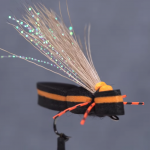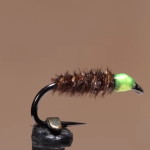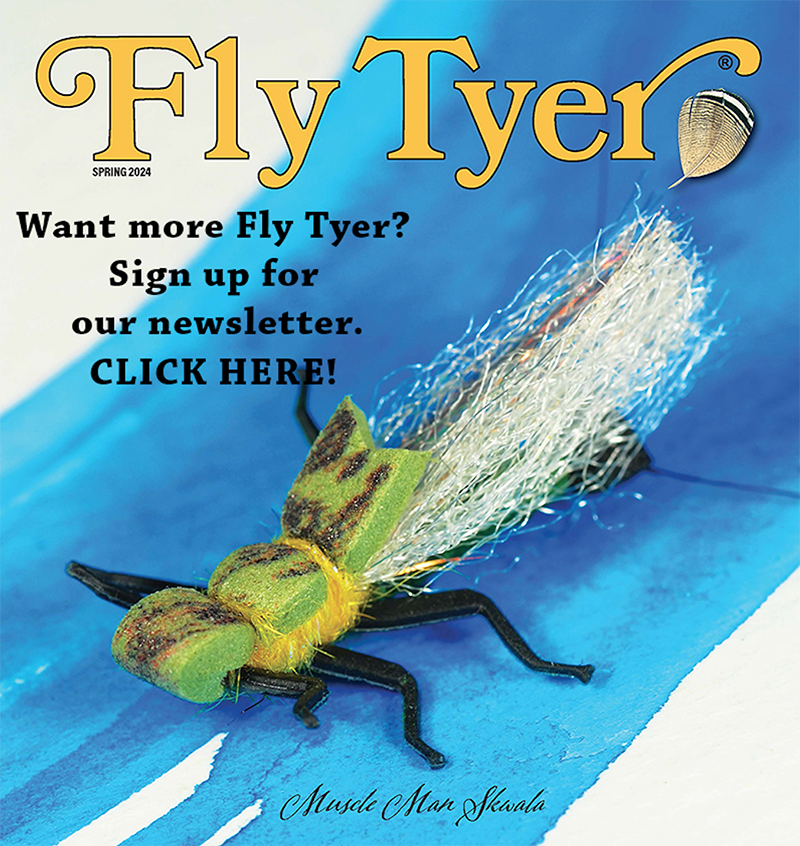Making new styles of patterns will reinvigorate all your time at the vise.
[by Barry Ord Clarke]
Any job or hobby has a monotonous side. Chores that you are not particularly fond of doing, but must do, help maintain this sense of monotony. This sometimes happens with our fly tying. If you’re down in the dumps or become bored with your tying, trying something new might be just the pickme-up you need to get your creative juices flowing and bring excitement to your time at the vise.
I have been tying flies, and writing articles and books about the subject, for several decades. I’ve been working at it full-time for the past 25 years. Unfortunately, with all this effort, a lot of people label me as an expert. The truth is, however, I am still a novice at many types of fly tying. Sure, I have a decent knowledge of materials and techniques that help with all my tying, but when I start making a style of fly that is unfamiliar to me, it’s like starting one of those books that you just can’t put down.
Every now and then, I embark on one of these fly tying journeys. Once upon a time, I got hooked on making adult caddisflies. I tied as many patterns as I could find, from the well known to the obscure. Another time it was saltwater patterns using exotic materials. These endeavors not only expanded my tying skills and knowledge of materials but also breathed new life into all my tying. I was trying something new!
Blue Devil Custom
HOOK: Partridge CS15, size 4. (You may substitute another brand of 6X- to 8X-long streamer hook of your choice.)
THREAD: White gel spun.
TAG: Flat silver tinsel.
BODY: Red silk floss.
RIB: Flat silver tinsel.
THROAT: White bucktail and a reddish-orange hen hackle.
WING: Eight to 10 strands of peacock herl, two reddish-orange hackles, and two blue hackles.
SHOULDER: Brownish-gray partridge hackle.
CHEEKS: Jungle cock.
Tie the Body of the Streamer
This Is One of Those Journeys
The first things that attracted me to classic streamers were their sheer elegance and length. I have had Alcock, Mustad, and Partridge long-shank streamer hooks in my fly tying bench for many years. On several occasions, I have taken them out, examined them, and considered what I could tie with them. I have occasionally tied flies on them, but not classic freshwater streamers.
These long, streamlined flies are beautifully constructed and come in amazing colors. They are true American gems! As I started looking more closely at the different patterns by Carrie Stevens, I found that, unlike classic Atlantic salmon flies, her patterns contained a minimum of exotic materials. The majority of the ingredients she used consisted of homegrown American hackle and bucktail. This sent me off on another tangent: Was her selection of materials by choice or through necessity? I had so many questions, and from where I live in Norway, I could find hardly any authoritative literature. I did, however, have the Internet.
After finding various pattern recipes, I started tying the flies. I posted a few images on Facebook and received pointers from several knowledgeable tiers, including Chris Del Plato. I quickly understood that Chris has vast knowledge about how to make Mrs. Stevens’s patterns, and he became my online resource. After asking many questions, I received a bunch of photocopies in the post—all the way from the United States—of articles Chris had written on the subject, including how to select hackles, construct the wings, proper proportions, and more. I had everything I needed to get started. Thank you, Chris!
Although I am only a humble apprentice in the art of tying feather-wing streamers, let me share with you a little of what I have learned. Maybe this style of tying will inspire you to tie some of these wonderful streamers. Maybe you will become inspired to begin a fly tying journey of your own.
A Brief Lesson in Making Classic Feather Wings
Finish the Blue Devil Custom
Barry Clarke is a regular contributor to our magazine. Although he is being humble in this article about his abilities, believe me, he is an expert tier; I am envious of his talents at the vise. Barry lives in Norway, but you’ll find him on his website, www.thefeatherbender.com. If you’d like to learn more about tying historic streamers, be sure to read Sharon E. Wright’s book titled Tying Heritage Featherwing Streamers (Stackpole Books). Sharon has occasionally contributed articles to our magazine, and her book has been hailed as the definitive source of how-to information on making this style of fly.










